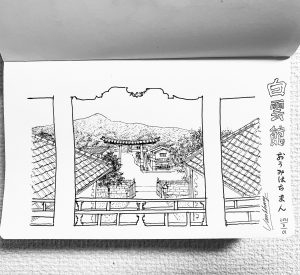Hello, I am Huynh Van Khang, doctoral researcher.
博士研究員のフィンバンカンです。
Last week, the research lab organized a field trip to the Omihachiman region. I am delighted to have joined all the old and new members of the lab. These sightseeing activities are very useful for learning architecture and observing life, which is very essential for the creativity of designers.
先週、研究室全体は近江八幡地域へのフィールドトリップを行きました。ラボの新旧のメンバー全員に加わったことをうれしく思います。これらの観光活動は、建築を学び、生活を観察するのに非常に役立ちます。これは、デザイナーの創造性にとって非常に重要と思います。
The charming river scenery along with the ancient buildings in the Omihachiman area has given me a lot of inspiration and thoughts. A question while sightseeing: Do buildings really have memories? Or just our memories?
I think the buildings are kind of the protein of memory.
近江八幡地域の古風な建物と魅力的な川の風景は、多くのインスピレーションと考えを与えてくれました。観光中の質問:建物には本当に思い出がありますか?それとも私たちの思い出だけですか?
建物は一種の記憶のたんぱく質だと思います。
Historical landmarks belong to a legacy of collective memory. When we encounter buildings where other lives once played out, memories are freed up, released from the walls where they have been resting for years. Buildings can convey experiences that go beyond an individual’s memory. The accumulation of experience is strengthened by characterful architecture and by preserving buildings more or less intact. Damage to a building is like damage to a database of experience, which can create stress and uncertainty. Even when they need to be torn down, we must realize that buildings are much larger than the physical volume they occupy.
歴史的建造物は集合的記憶の遺産に属しています。かつて他の生活が繰り広げられていた建物に出会うと、記憶が解き放たれ、何年も休んでいた壁から解放されます。建物は、個人の記憶を超えた体験を伝えることができます。経験の蓄積は、特徴的な建築と建物を多かれ少なかれ無傷で保存することによって強化されます。建物の損傷は、経験のデータベースへの損傷のようなものであり、ストレスや不確実性を生み出す可能性があります。解体する必要がある場合でも、建物は物理的な体積よりもはるかに大きいことを認識しておく必要があります。
 My drawing is bad but I send everyone a sketch of the view from a window in Hakuunkan, where give me a lot of thoughts about the hierarchy of nature and the historical land.
My drawing is bad but I send everyone a sketch of the view from a window in Hakuunkan, where give me a lot of thoughts about the hierarchy of nature and the historical land.
まだ下手ですが、自然の階層や史跡の土地について多くのことを考えている白雲館の窓からの眺めのスケッチをみんなに送ります。
では…

